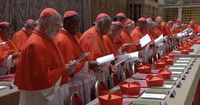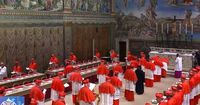On May 7, 2025, 133 cardinals gathered at the Sistine Chapel in Vatican City to begin the conclave to elect a successor to Pope Francis. This significant event marks a pivotal moment for the Catholic Church, as the cardinals prepare to select the 267th pope following the passing of Pope Francis.
The conclave commenced at 16:30 Vatican time (21:30 Vietnam time), with the cardinals moving in a solemn procession from the Pauline Chapel to the Sistine Chapel. The atmosphere was charged with anticipation as the cardinals entered the chapel, a site adorned with Michelangelo's magnificent fresco, "The Last Judgment." This artwork serves as a backdrop for the sacred and secretive voting process that is about to unfold.
In adherence to longstanding tradition, the cardinals surrendered all electronic communication devices, including phones, tablets, and smartwatches, to ensure confidentiality during the proceedings. Vatican officials enforce these rules rigorously, underscoring the importance of secrecy in this momentous selection.
Upon entering the chapel, the cardinals recited an oath to maintain the secrecy of the conclave, a critical step in preserving the integrity of the election process. Archbishop Diego Giovanni Ravelli, who oversees the papal liturgical ceremonies, then commanded "Extra omnes," a Latin phrase meaning "everyone out," signaling the departure of all non-participants from the Sistine Chapel.
With the chapel doors firmly closed, attention shifted to the chimney atop the chapel, which will signal the outcome of the votes cast within. For centuries, no pope has been elected on the first day of a conclave, leading many to anticipate that the voting process may extend over several days before a candidate secures the two-thirds majority required to become pope.
The voting occurs in secret, but the ballot counting is a public affair. Three cardinals are designated to oversee the counting process, reading the ballots aloud and documenting the results. After the votes are counted, the ballots are burned in a special stove, with additives introduced to produce the necessary smoke color. Black smoke indicates that no decision has been reached, while white smoke signifies the election of a new pope.
On the first day of the conclave, only one ballot is typically held. If no candidate achieves the required majority of 89 votes, the process will be repeated for up to four rounds each day over the next two to three days. If a new pope is not elected by the end of the third day, the cardinals will take a day for prayer and discussion, reflecting on the guidance offered by senior cardinals.
If, after 33 rounds of voting, no candidate has garnered enough support, the cardinals will then proceed to a vote involving the two candidates who have received the most backing. The new pope will then emerge on the balcony of St. Peter's Basilica, greeting the faithful and offering prayers before presiding over a mass a few days later to mark the beginning of his papacy.
The anticipation surrounding this conclave is palpable, not only among the cardinals but also among the millions of Catholics around the world who await news of their new spiritual leader. As the cardinals cast their votes, the eyes of the global community are fixed on the Vatican, eager to witness the outcome of this sacred process.
Throughout history, the conclave has been a moment of great significance for the Catholic Church, often reflecting the evolving values and challenges faced by the Church in contemporary society. As the cardinals deliberate and vote, they carry with them the hopes and prayers of the faithful, seeking guidance and wisdom in selecting a leader who can navigate the complexities of the modern world while upholding the core tenets of the Catholic faith.
The conclave's proceedings will continue until a new pope is elected, a process steeped in tradition and solemnity. The world awaits the white smoke that will signal the arrival of a new leader, a moment that will undoubtedly mark a new chapter in the history of the Catholic Church.


